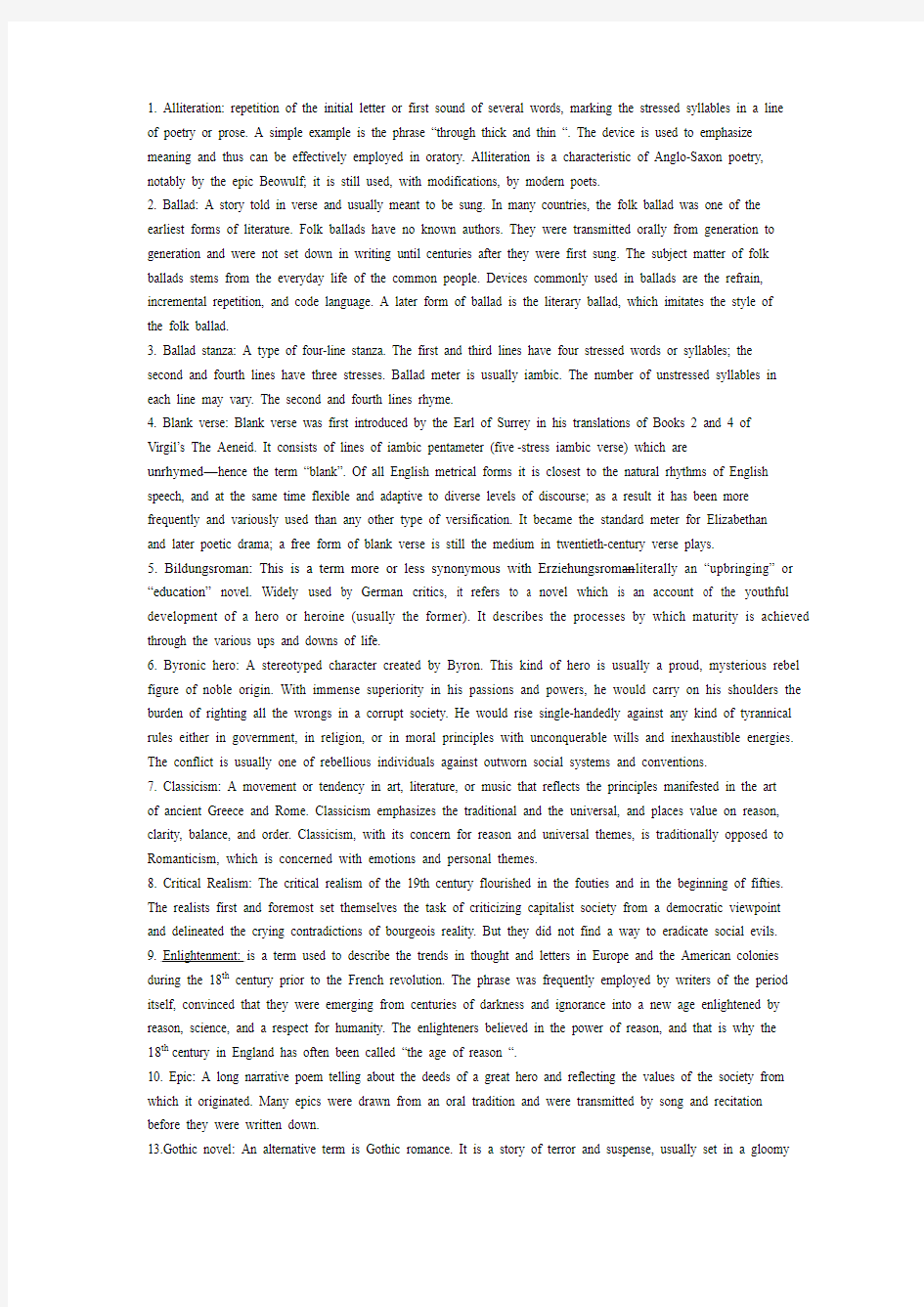英美文学名词解释

- 1、下载文档前请自行甄别文档内容的完整性,平台不提供额外的编辑、内容补充、找答案等附加服务。
- 2、"仅部分预览"的文档,不可在线预览部分如存在完整性等问题,可反馈申请退款(可完整预览的文档不适用该条件!)。
- 3、如文档侵犯您的权益,请联系客服反馈,我们会尽快为您处理(人工客服工作时间:9:00-18:30)。
1. Alliteration: repetition of the initial letter or first sound of several words, marking the stressed syllables in a line of poetry or prose. A simple example is the phrase “through thick and thin “. The device is used to emphasize meaning and thus can be effectively employed in oratory. Alliteration is a characteristic of Anglo-Saxon poetry, notably by the epic Beowulf; it is still used, with modifications, by modern poets.
2. Ballad: A story told in verse and usually meant to be sung. In many countries, the folk ballad was one of the earliest forms of literature. Folk ballads have no known authors. They were transmitted orally from generation to generation and were not set down in writing until centuries after they were first sung. The subject matter of folk ballads stems from the everyday life of the common people. Devices commonly used in ballads are the refrain, incremental repetition, and code language. A later form of ballad is the literary ballad, which imitates the style of the folk ballad.
3. Ballad stanza: A type of four-line stanza. The first and third lines have four stressed words or syllables; the second and fourth lines have three stresses. Ballad meter is usually iambic. The number of unstressed syllables in each line may vary. The second and fourth lines rhyme.
4. Blank verse: Blank verse was first introduced by the Earl of Surrey in his translations of Books 2 and 4 of Virgil’s The Aeneid. It consists of lines of iambic pentameter (five-stress iambic verse) which are unrhymed—hence the term “blank”. Of all English metrical forms it is closest to the natural rhythms of English speech, and at the same time flexible and adaptive to diverse levels of discourse; as a result it has been more frequently and variously used than any other type of versification. It became the standard meter for Elizabethan and later poetic drama; a free form of blank verse is still the medium in twentieth-century verse plays.
5. Bildungsroman: This is a term more or less synonymous with Erziehungsroman—literally an “upbringing” or “education” novel. Widely used by German critics, it refers to a novel which is an account of the youthful development of a hero or heroine (usually the former). It describes the processes by which maturity is achieved through the various ups and downs of life.
6. Byronic hero: A stereotyped character created by Byron. This kind of hero is usually a proud, mysterious rebel figure of noble origin. With immense superiority in his passions and powers, he would carry on his shoulders the burden of righting all the wrongs in a corrupt society. He would rise single-handedly against any kind of tyrannical rules either in government, in religion, or in moral principles with unconquerable wills and inexhaustible energies. The conflict is usually one of rebellious individuals against outworn social systems and conventions.
7. Classicism: A movement or tendency in art, literature, or music that reflects the principles manifested in the art of ancient Greece and Rome. Classicism emphasizes the traditional and the universal, and places value on reason, clarity, balance, and order. Classicism, with its concern for reason and universal themes, is traditionally opposed to Romanticism, which is concerned with emotions and personal themes.
8. Critical Realism: The critical realism of the 19th century flourished in the fouties and in the beginning of fifties. The realists first and foremost set themselves the task of criticizing capitalist society from a democratic viewpoint and delineated the crying contradictions of bourgeois reality. But they did not find a way to eradicate social evils.
9. Enlightenment: is a term used to describe the trends in thought and letters in Europe and the American colonies during the 18th century prior to the French revolution. The phrase was frequently employed by writers of the period itself, convinced that they were emerging from centuries of darkness and ignorance into a new age enlightened by reason, science, and a respect for humanity. The enlighteners believed in the power of reason, and that is why the 18th century in England has often been called “the age of reason “.
10. Epic: A long narrative poem telling about the deeds of a great hero and reflecting the values of the society from which it originated. Many epics were drawn from an oral tradition and were transmitted by song and recitation before they were written down.
13.Gothic novel: An alternative term is Gothic romance. It is a story of terror and suspense, usually set in a gloomy
